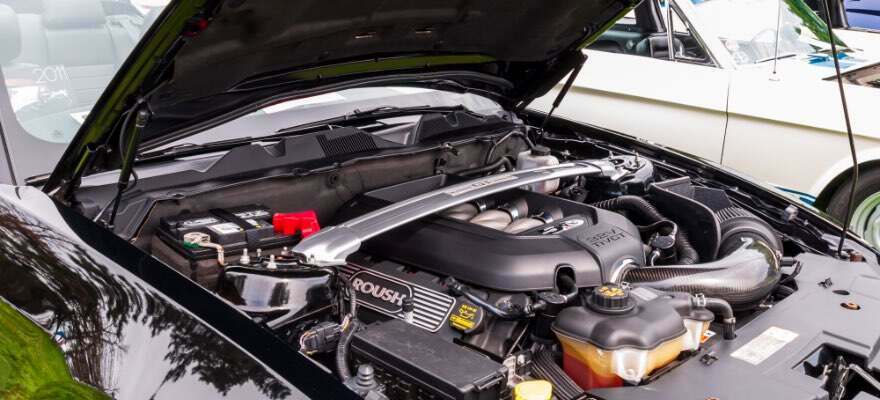What Is the Difference Between an OHV and OHC Engine?
The difference between an OHV and OHC engine is all about the configuration of the cylinder heads. OHV stands for overhead valve, whereas OHC means overhead cam. An OHV engine has a camshaft placed between the engine's cylinder heads, also known as "cam-in-block." The crankshaft connects to the cam, so they turn in tandem. As the camshaft turns, a pushrod causes the valves on top of the engine to open and close.
On the other hand, on OHC engines, the camshaft (or camshafts) are on top of the cylinder heads, controlling the intake and exhaust valves.
What Is a Pushrod Engine?
A pushrod engine is simply another name for an OHV engine, named so because of the engine's use of a pushrod for operations. OHC engines can be referred to as modular engines because of their setup.
Pros and Cons of an OHV or Pushrod Engine

Introduced in the 40s, some drivers think of the OHV engine as being outdated. That said, it certainly has its defenders. Let's take a look at some of the advantages and disadvantages of installing a pushrod engine in your ride.
OHV Engine Pros
Putting in a pushrod engine is worth consideration, especially for the following reasons:
- Classic Style — When you think of classic American muscle, an OHV engine is a big part of it. While this will be subjective from driver to driver, the cam-in-block style just screams "old school," and for some folks, that's enough to give it the thumbs up.
- Size — OHC engines are bigger and heavier because of the placement of the camshaft (and addition of more camshafts in most cases).
- Cost — OHV engines are more cost-effective upfront and generally cost less to maintain. They're also known for lasting a long time.
- Low-End Torque — While the tides may be shifting, the pushrod engine is still known for having better low-end torque because of the way its valves work, creating a better air and fuel mixture.
OHV Engine Cons
You might think twice about using OHV engines for these factors:
- More Potential for Failure — Even though they tend to be durable, OHV engines have many moving parts, which means they have more potential points of failure. Additionally, the pushrods tend to warp and flex over time.
- Less Control over Valve Timing — At higher RPMs, it's way harder to control the valve timing because there are so many components. Pushrod flex also decreases accuracy. While modern OHC engines often have built-in variable cam timing, OHVs simply don't naturally have that level of control.
Pros and Cons of OHC Engines

First of all, it is crucial to note that there are two types of OHC engines: SOHC and DOHC, with both utilizing a design that puts the camshaft(s) at the height of the cylinder heads rather than in-block. SOHC stands for Single Overhead Cam, meaning there is one camshaft for the intake and exhaust valves, while DOHC means Double (or Dual) Overhead Cam, using two separate camshafts to control the intake and exhaust valves separately. We'll compare pushrod vs. DOHC and SOHC below.
SOHC vs. OHV
While DOHC might be more common, it's still worth comparing SOHC vs. OHV.
- Pro: OHC engines allow for more precise timing, especially at high RPMs, because the valves are operated directly by the camshaft.
- Con: A timing belt or chain is required, and this has to be replaced periodically.
- Con: Separate variable valve timing for exhaust and intake valves is complicated (a problem solved with DOHC engines).
DOHC vs. OHV
Most new cars off the line today are equipped with DOHC engines. When comparing pushrod vs. DOHC for your ride, you'll want to keep these factors in mind.
- Pro: DOHC engines can achieve more direct airflow because the dual camshafts allow for a larger angle between the intake and exhaust valves.
- Pro: More breathing room means more horsepower and more high-end torque (though pushrod engines still have better low-end torque).
- Pro: Variable valve timing can easily improve power and fuel efficiency.
- Pro: DOHCs can hit way higher redlines than OHV engines due to a higher rev ceiling.
- Con: All OHC engines are heavier because of additional components, especially those with dual overhead cams.
- Con: These also need a timing belt or chain.
Pushrod vs. OHC: Which One Wins
To be frank, it really comes down to personal preference and what you're trying to get out of a specific build. We'll give you our final breakdown to help you decide where your loyalty lies in the battle of OHV vs. OHC.
OHVs are known for durability, longevity and ease of maintenance. While OHC engines are generally reliable, if they do have problems, they're usually much bigger problems. With more moving parts that are all connected (particularly the timing chain tying together the camshafts, pistons and crankshaft), if one thing goes wrong with an OHC, it can all go wrong. However, a pushrod engine can't beat the rev range, smoothness and fuel efficiency of a modular engine, no question.
Let's face it — in modern cars, you really only see OHV engines in Chevys, so you know where we stand.
“Aerodynamics are for people who can't build engines.”
- Enzo Ferrari
Find Parts and Accessories for DOHC and SOHC Engines
Comparing OHV vs. OHC, it doesn't matter which side you're on — Lethal Performance can help you get the killer ride of your dreams. While we specialize in modern Mustang OHC engines, you'll find OHV parts in our store as well. Browse our selection today!
Shop Lethal Performance


.jpg)

